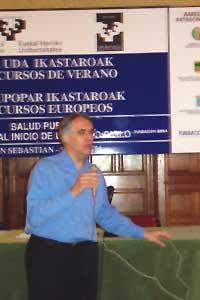Public health: new challenges for the new century
That is Josep M. Title of the conference of Antó i Boqué in the UPV summer courses. He works at the Municipal Institute of Medical Research and BerHarka University in Barcelona.
In his opinion, public health is constituted by environmental factors alien to individual control and, in particular, by physical and biological conditions. As a particularity, he points out that in public health, in many cases, it is sufficient to identify and correct the factors that have caused the epidemic or risk situation, without having an absolute knowledge of epidemiology.
The problems that arise within the so-called public health are divided into local and general.
Problems affecting specific areas under local conditions. So are epidemics. These usually arise spontaneously, often complex and new (occurrence of unknown problems, diseases, pathogens...). In some cases, although the problem can be solved without epidemiological studies, this research is subsequently necessary.

Industrial accidents are also local problems (most). These accidents, from the technical-industrial point of view, are ‘very difficult to produce’, but from the point of view of environmental health they are ‘most likely’ and can be very serious. The question is from the industrial or health point of view. This type of accidents in developing countries is easier, but also more difficult to know. It is not always easy to investigate about them, as it depends on local resources. And even if it seems a lie, sometimes it is not easy to establish the protocols to follow in research and data collection. In any case, the interpretations and statistics of the data, whether significant or not, are usually debatable.
Finally, the so-called ‘pollution zones’ (incinerators, landfills...) have been referred to as local problems. In them, he points out that it is often very difficult to establish a relationship between the pollutant and the inhabitants/disease/death factors. Sometimes due to the difficulty of isolating and identifying pollutants and in others due to the difficulty of obtaining disease and death data. For example, the research carried out around 10 incinerators (between 3 and 10 km) indicated that it did not affect the number of deaths, not even the distance, but did not take into account non-fatal diseases. Or a study on landfills indicated that the inhabitants of the area had a double risk of anomalies (neurological, cardiac, arterial, respiratory...) and that they depended on distance, but could not determine what caused, since there was no data on dumping to landfill.
In general, local problems present deficiencies in the regulation of risks to the environment, as well as in surveillance and control mechanisms, generating a social gravity and a low capacity for individual response.
He also mentioned the ‘general’ problems of public health: electromagnetic fields, low-frequency waves, low air pollution, presence of passive smoker, radon in homes, materials containing chlorine and water, various chemical components... All of them often have little incidence on individual health, not very strong, but as it affects many people can become a serious problem. In addition, in many cases, their research is more difficult than the investigation of local problems, due to a low level of exposure, low individual impact, very large research samples, problems of separation of components from pollution, problems of interpretation, etc.
For all these problems, the ‘Model of Health Protection against Environmental Risks’ is currently in force, which analyzes, manages and communicates risk to society, but Josep believes that the model is very rigid and has limits. In fact, it requires demonstrating the damage, only analyzes 5% of the possible risks, does not consider the combinations between risks, requires very rigorous scientific research (the most appropriate but requiring consequences to work) and the institutional point of view is not adequate (there is only an agency for carcinogens and other subjects, which implies an inaction of research). And to overcome all this, he proposes to act according to the ‘precautionary criteria’, that is, instead of being left without doing anything if data is not available, acting prudently and ensuring prior security rather than acting by repairing the damage. After all, just like today it is played with medicines.
Buletina
Bidali zure helbide elektronikoa eta jaso asteroko buletina zure sarrera-ontzian











